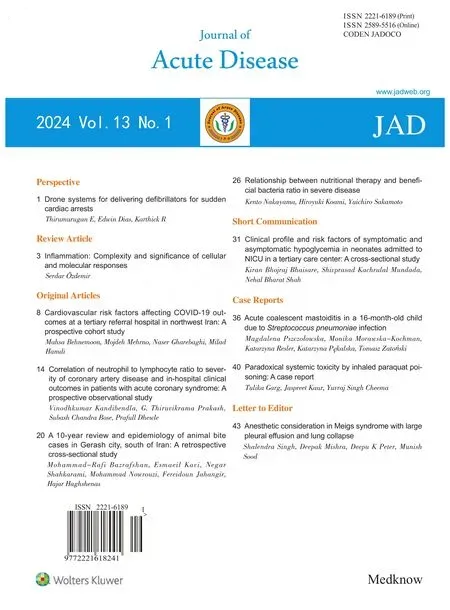Drone systems for delivering defibrillators for sudden cardiac arrests
Thirumurugan E ,Edwin Dias ,Karthick R
1Srinivas University,Mangalore,Karnataka,India
2Faculty of Allied Health Science,DR MGR Educational and Research Institute,ACS Medical College,Chennai,Tamil Nadu,India
Unmanned aerial vehicles (UAVs),or drones,that were initially developed for military use during World War I[1],have evolved into highly sophisticated aircraft that can be navigated remotely using global positioning systems.With constant improvements,drones have become more efficient,and cost-effective,with longer battery life and greater loading capacity.Today,UAVs have proven to be an effective and affordable solution for enhancing healthcare accessibility for patients who face geographical or infrastructural barriers.Using drone networks can greatly reduce the time transporting life-saving equipment,such as delivering automated external defibrillators (AEDs),to cardiac arrest victims,and can provide quick assistance to reduce travel time for the patients.
Recent estimates show insufficient progress,with around 395 000 adults experiencing out-of-hospital cardiac arrest (OHCA) each year[2].Using AED is one of the most effective treatment options for OHCA cases.Extensive research has proven that prompt administration of defibrillation increases the likelihood of survival by 40%-70%[3].OHCAs frequently occur in private homes in rural areas,where emergency response is delayed,resulting in lower survival rates[4].As a result,novel strategies are required to improve access to AEDs and reduce the time required for defibrillation.Several organizations and researchers have developed drone technology in recent years to meet this requirement,which can be used to transport AEDs[5].Although the use of drones to deliver AEDs in this context is still in its early stages,this article outlines drones' safety,efficacy,and compatibility in delivering AEDs and aims to serve as a source of information and to promote further research on this innovative technique.
When an emergency call is received,the operator quickly evaluates the situation and delivers clear and concise cardiopulmonary resuscitation instructions to the caller,if necessary.Meanwhile,an automated control center is simultaneously alerted to dispatch a drone,ensuring swift and efficient response times.To ensure safety and compliance with regulations,it is imperative for drone pilots to properly communicate and obtain authorization from air traffic control before every flight.The drone must be 500 feet (150 meters) above sea level within the designated airspace[6].This protocol should be diligently followed to maintain safety and responsibility in drone operations.The drone relies on global positioning system coordinates from the caller's phone to respond promptly to emergencies.Upon arriving at the specified location,the AED device is automatically activated,and the emergency operator expertly guides the user through the necessary steps.The drone then safely returned to the hangar,completing the mission efficiently and accurately.
Schierbeck et al.in 2022[7],and Claesson et al.in 2016 and 2017[8,9],conducted studies on transportable life-saving equipment in OHCA cases found that the deliveries of AED are successful,with success rates as high as 92%,93%,and 100%,respectively.These studies also found that compared to ambulance,the times required for AEDs to be delivered into the hands of those needed are greatly reduced,which save 01:52 min,19:00 min,and 16:39 min,respectively.
Using drones for delivering defibrillators has many benefits,including quick assistance,reduced travel time for the patient,improved basic operations of medical emergency teams,and the ability to travel to locations not accessible by conventional medical transport (for example due to floods and blocked roads).Drones have demonstrated a remarkable ability to address the persistent mobility challenges that impede the attainment of universal health coverage in geographically isolated and underdeveloped regions.In particular,drones present a promising solution for meeting healthcare targets in remote areas where traditional modes of transportation are often inadequate or unavailable[2].However,the potential for drones to be hacked and the possibility of collisions with buildings or other aircraft are significant drawbacks.Hence,before attempting to enter clinical practice,a more comprehensive study would be required to establish the safety and feasibility of drones over broader geographic areas and address core technical challenges.
Conflict of interest statement
The authors report no conflict of interest.
Funding
This study received no extramural funding.
Authors’ contributions
TME and ED developed the concept;KR acquired the data.All the authors contributed to the analysis and interpretation of the data and writing the article.
 Journal of Acute Disease2024年1期
Journal of Acute Disease2024年1期
- Journal of Acute Disease的其它文章
- Inflammation:Complexity and significance of cellular and molecular responses
- Anesthetic consideration in Meigs syndrome with large pleural effusion and lung collapse
- Paradoxical systemic toxicity by inhaled paraquat poisoning:A case report
- Acute coalescent mastoiditis in a 16-month-old child due to Streptococcus pneumoniae infection
- Clinical profile and risk factors of symptomatic and asymptomatic hypoglycemia in neonates admitted to NICU in a tertiary care center:A cross-sectional study
- Relationship between nutritional therapy and beneficial bacteria ratio in severe disease
